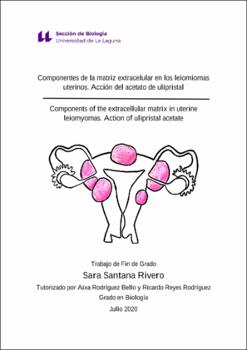Componentes de la matriz extracelular en los leiomiomas uterinos: acción del acetato de ulipristal
Autor
Santana Rivero, SaraFecha
2020Resumen
El leiomioma uterino (LU) es la neoplasia benigna más común del aparato
reproductor femenino, presentando una alta prevalencia durante la edad reproductiva.
Clínicamente los leiomiomas pueden presentarse con una gran variedad de síntomas
como dolor intenso y hemorragias. La morbilidad causada por estos tumores está
directamente relacionada con el aumento de su tamaño. Los datos existentes indican que
la acumulación excesiva de matriz extracelular (MEC) estructuralmente desordenada en
los leiomiomas contribuye a su crecimiento. Asimismo, varios factores como los micro
ARNs, las hormonas ováricas, la diferenciación de fibroblastos en miofibroblastos
(MFB), los factores de crecimiento y las citocinas también se han relacionado con su
desarrollo, por su acción sobre la MEC. Hasta ahora la cirugía sigue siendo la opción
definitiva para el tratamiento de esta patología, por lo que es necesario el desarrollo de
un tratamiento médico eficaz. El acetato de ulipristal (UPA) se ha considerado uno de los
tratamientos más prometedores por su papel modulador de los receptores de progesterona,
la cual juega un papel fundamental en el desarrollo y crecimiento del LU. Esta revisión
se centra en el papel de la matriz extracelular y de factores que actúan sobre ella en el
desarrollo del leiomioma, además, se analizará el papel del acetato de ulipristal sobre los
componentes de la matriz.. Uterine leiomyoma (UL) is the most common benign neoplasm of the female
reproductive system, presenting a high prevalence during reproductive age. Clinically,
leiomyomas can present a wide variety of symptoms such as severe pain and bleeding.
The morbidity caused by these tumors is directly related to the increase in their size.
Existing data indicates that excessive accumulation of structurally disordered
extracellular matrix (ECM) in leiomyomas contributes to their growth. Likewise, several
factors such as micro RNAs, ovarian hormones, fibroblast differentiation into
myofibroblasts, growth factors and cytokines have also been related to their development,
due to their action on the ECM. Until now, surgery remains the definitive option for the
treatment of this pathology, which is why the development of effective medical treatment
is necessary. Ulipristal acetate (UPA) has been considered one of the most promising
treatments, due to its modulating role of progesterone receptors, which plays a
2
fundamental role in the development and growth of UL. This review focuses on the role
of the extracellular matrix and the factors that act on them in the development of the
leiomyoma, as well as the role of ulipristal acetate on the components of the matrix.





